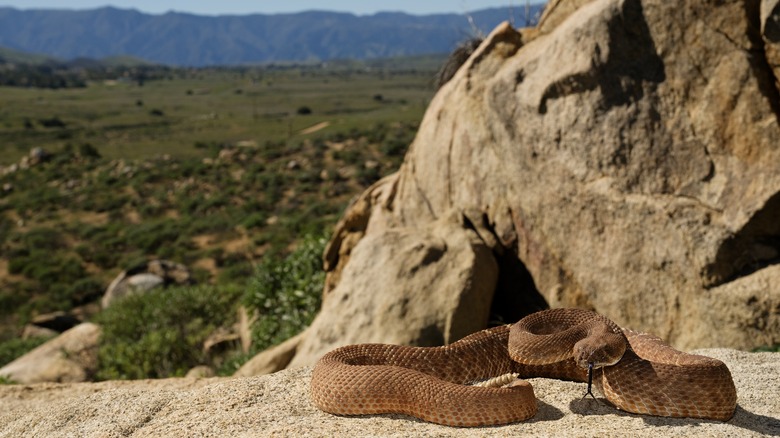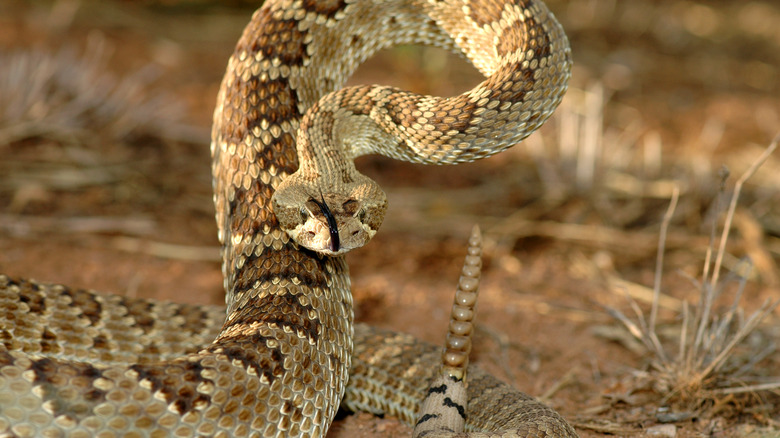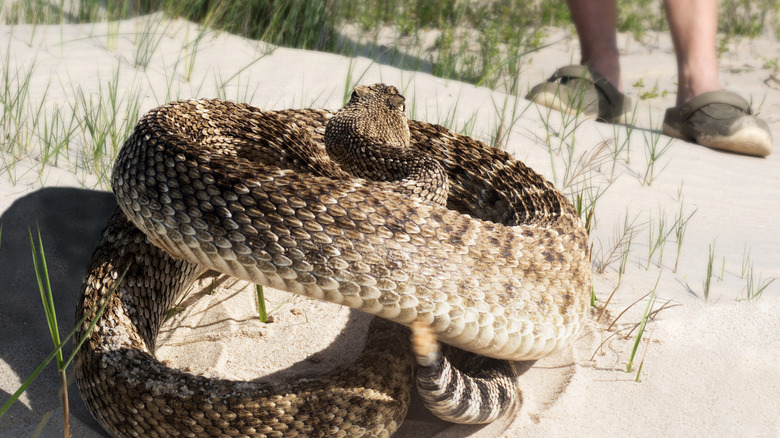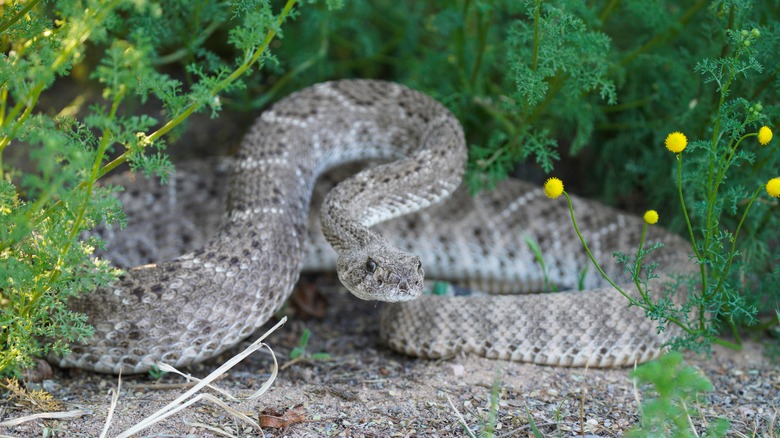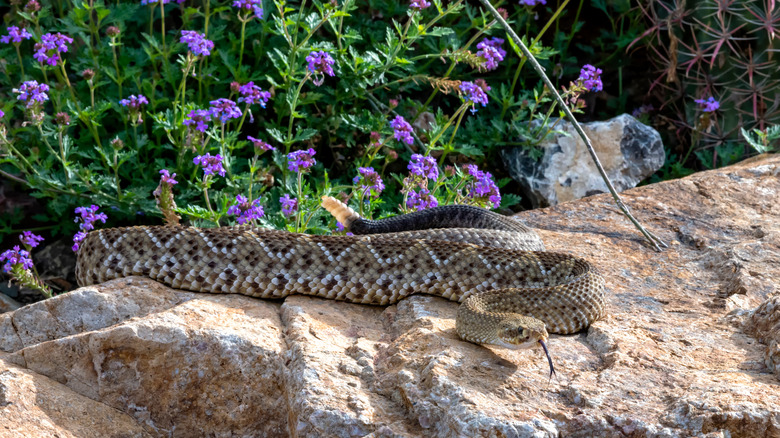What To Do If You Run Into A Rattlesnake While Hiking
On a warm, sunny day, there's nothing more enjoyable than going for a hike in the fresh air. Enjoying the scenery as you get some exercise refreshes your mind as well as your body. As you make your way down a desert trail or up a mountain path, it's a good idea to keep in mind that other creatures may appear along your journey who enjoy the warm sunshine as much as you do, even a rattlesnake. It's important to be prepared and know how to respond if this type of encounter should ever take place. The best tips to remember are to give the snake plenty of room, stomp your feet to encourage it to leave on its own, and never try to pick one up.
Rattlesnakes are mostly dormant during the cold winter months, and they become more active in the spring and summer when the temperature warms up. If you were to see one during a hike, it would probably take place between the months of April through October. However, it's possible to encounter a rattlesnake any day of the year when it's warm outside, which is why it's wise to be prepared. "Snakes don't have a calendar," says Russ Johnson, President of the Phoenix Herpetological Society (via AZCentral). "Once it gets warm out, they are coming out." For this reason, it's essential to think ahead and consider the best way to prepare for a possible encounter with a rattlesnake.
Prepare beforehand
If you know that you'll be hiking in an area where rattlesnakes have been sighted, it's best to plan for a potential encounter before you begin your trip. Learn about the trail conditions for the area you're planning to visit by consulting trip reports from other hikers. Choose trails that are open and not covered in heavy brush, where snakes often hide, and follow a route that is often used so that the rattlesnakes have already moved out of the area. There are a few pieces of equipment that you should include in your pack. If you'll be in a remote area where rattlesnakes have been seen, bring a satellite device that would be useful in the event that you need help. Bring a hiking pole to move brush out of the way, and include a non-retractable leash for your dog if he's coming with you.
Once on the trail, always step onto a rock or log so that you can see where your foot will land on the other side. Don't step over an obstacle into a spot that you can't see, and stay observant about where you're placing your hands when you're climbing. You may want to leave some items at home, such as earphones, so that you can listen to the sounds of the environment to hear any clues that a rattlesnake may be nearby. When possible, hike with a buddy so that you have each other's support in the event of a rattlesnake encounter.
Learn how to identify a rattlesnake
Rattlesnakes aren't the only kinds of snakes you may discover while hiking, but it's helpful to be able to identify this venomous snake if you see one. Their best known trait is their rattle and the ominous sound it makes when they sense danger nearby. This rattle will grow a new section each time the animal sheds its skin, sometimes growing up to 10 segments long. However, don't depend on this one distinguishing characteristic as the only way to identify these snakes. These rattles can sometimes break off and leave the snake without this warning sign to alert hikers to their presence.
One very distinctive characteristic of a rattlesnake is its triangular-shaped head that tapers into a narrow neck. This feature sets them apart from other snakes, and it is a certain way to identify one if you see it. Rattlesnakes are only found in the Americas, and there are over 50 known species existing today. There are 20 species of rattlesnakes in North America, with the highest concentration of them living in the Southwest. Their thick scales are usually earth-toned in color, and they can be found not only in the desert but also in forests, swamps, or even swimming in water. On particularly hot days, they may hide under logs, rocks, or piles of tall brush. They can range in size from just one foot long to the largest eastern diamondback rattlesnake, which is eight feet long.
Understand their behavior
Because rattlesnakes are cold-blooded, they depend on their environment to find a source of heat. For this reason, they're often seen on a hiking trail where they can soak up the sunshine. However, when it becomes too hot, they will retreat into the shade under a rock or hide themselves in the brush. It's always best to be on the alert to their potential presence nearby on these warmer days so that you don't accidentally startle one.
Rattlesnakes prey on rodents and are really not interested in coming in contact with people. They will not become aggressive unless they feel threatened, and it is very likely that they will try to move away from you on their own. However, keep in mind that they can move very quickly. If a rattlesnake is startled or senses danger, it can lunge up to two thirds of the length of its body. Even if a snake appears to be sleeping in the sun, never take a chance and step over one as it can strike suddenly. This means that it's not worth the risk to try to get a close look at (or photograph of) this creature. It's best to stay at least ten paces away from a rattlesnake if you see one.
Be alert to your surroundings
If you do hear the distinctive sound of a rattlesnake as you're walking down a path, stop immediately. Move slowly and cautiously as you carefully evaluate your surroundings to determine where the noise is coming from. It's important to pinpoint the snake's location before you act hastily in an attempt to escape. In your efforts to avoid the snake, you don't want to accidentally move closer to it and make it more defensive. If there are children with you, instruct them to stay very still. If you haven't already done so, put your dog on a leash immediately. Use your hiking pole to move brush out of the way.
If you discover where the rattlesnake is located, move cautiously away to put as much distance as possible between the two of you, and observe its behavior as you do so. It may already be planning its escape route and slithering away. However, if the snake feels cornered or threatened, it will coil itself into a position that's ready to strike. It will only attack you as a last resort, but you can observe from its behavior whether a strike is imminent, as it can only do so when it is coiled. Keep your hiking pole between you and the snake so that if it does lunge toward you, it contacts the pole rather than you.
Give the snake a chance to retreat
It's possible that the rattlesnake you've discovered has found its favorite sunny perch and refuses to move. In some cases, the best solution is simply to turn around and find another trail out of the area. Waving your arms and shouting at a rattlesnake will not make it move faster, and it may only make it more defensive and act aggressively. Throwing rocks or sticks at the snake is also a bad idea, and never try to pick one up and move it yourself. One study concluded that up to 67% of rattlesnake bites occurred as a result of a person trying to move, capture, or kill the snake themselves, per the Natural History Museums of Los Angeles County.
If you decide to pass by the snake, do so in a manner that doesn't antagonize it. Rattlesnakes cannot hear, but they can feel vibrations very well. Stomping on the ground, from several feet away, can be the best method to encourage a rattlesnake to move. It will feel the sensation from your footsteps, and it will likely respond by moving away from the source of the vibrations. Give the snake plenty of room to find a way of escape, and be patient. Facing a potential encounter with a rattlesnake should never discourage you from enjoying your favorite hiking trail. By being prepared, educated, and alert to your surroundings, you'll be able to enjoy every moment that you spend outdoors.
